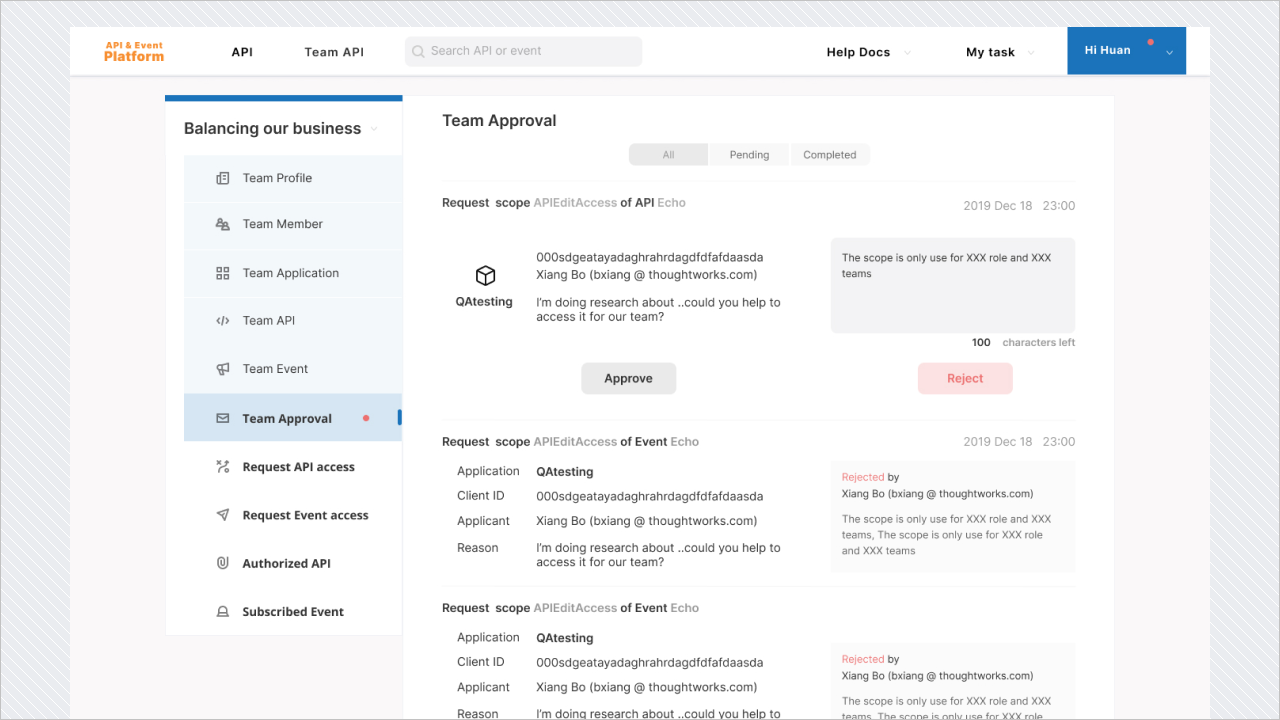API Platform for Centralized Management
Overview
From 2017 to 2019, I led a team to successfully develop an internal API platform, focused on addressing various pain points in API development and management. By standardizing API publishing, improving user experience, and providing more efficient API governance mechanisms, we significantly enhanced the usability, security, and manageability of our APIs. This platform not only provided convenient development tools for technical staff but also offered a simple and intuitive data management interface for non-technical users.
Business Challenges
As the company rapidly expanded, the need for system upgrades and quick business response became increasingly critical. However, we faced the following challenges in API development and publishing:
Lack of Unified Standards: Different teams published APIs using various interface formats, leading to a poor user experience on the consumer side. While developers could invoke APIs through CLI technologies, non-technical users lacked a tool for visualizing and browsing data.
Fragmented API Management: Consumers were unable to browse available APIs on a unified platform, and the business tags were disorganized, making API consumption difficult.
Disorganized Data Interchange: The company had dozens of business systems, but data interchange between these systems was chaotic and lacked effective governance.
Insufficient Security and Permission Management: There was a lack of effective security controls and permission management for API consumption, making it unclear who was calling the APIs, and the maintenance of these permissions was not timely.
Lack of Comprehensive Planning: From an organizational perspective, API planning lacked a holistic view, with poor reusability and governance efficiency needing improvement.
Research
To address these issues, I led the team in conducting extensive research, analyzing existing API management platforms on the market, and exploring various potential technical solutions. We conducted in-depth user interviews with both current internal API publishers and consumers to understand their pain points and needs, ultimately designing a comprehensive internal API platform solution.
Solution
Based on our research, we successfully built the TW internal API platform, where I was responsible for product design, development, and subsequent optimization. The specific solutions included:
Unified API Publishing and Management: We provided consumers with a marketplace-like platform where users could browse available internal APIs categorized by business domain. This greatly improved the discovery and usage experience of APIs.
User-Friendly Publishing and Editing Process: We offered API publishers a more convenient process for publishing and editing APIs, while also establishing a unified business tagging and classification system, ensuring API granularity better suited consumer needs.
Enhanced Security and Permission Management: We introduced stricter access permission management mechanisms to the platform, ensuring that every API access was traceable and making the permission management system more systematic.
Unified API Governance: The platform facilitated end-to-end API management, from publishing to accessibility status monitoring, ensuring the standardization of API data fields and significantly improving governance efficiency.
Support for Business Users: In addition to providing technical documentation for developers, we also provided Master Data management tools for business users, enabling them to create and manage source data from a non-technical perspective and automatically generate standardized API interfaces.
Benefits
By implementing this solution, we achieved significant improvements in several areas:
Increased API Usage Efficiency: The standardization and classification of APIs made their discovery and usage more convenient, reducing development time.
Enhanced System Security: Strict permission management and access log tracking significantly improved API security.
Faster Business Response: The tools provided for business users were easy to use, which greatly increased the speed at which business needs could be met.
Optimized API Governance: The unified API standards and governance processes improved API reusability, reduced redundant development, and enhanced overall efficiency.
User Feedback
Since the platform's launch, we have received very positive feedback from users. The technical team reported that the new API platform greatly simplified the development and management process, reducing the time required to publish interfaces. The business team particularly appreciated the platform's visualization features and the simple, easy-to-use Master Data management tools, noting that they significantly improved work efficiency and accelerated business decision-making. Overall, the API platform has been widely recognized and has laid a solid foundation for the company's internal digital transformation.



